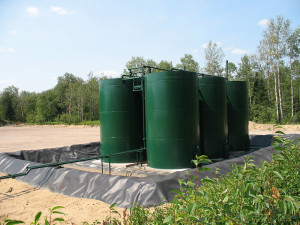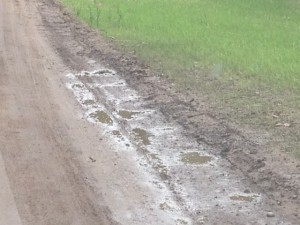Guest Blogger and FLOW Board Member Emma Lui is the Water Campaign Director for the Council of Canadians. She shared her recent blog post with us about her recent trip to Kalkaska, MI. Read the original post on canadians.org
Driving into Kalkaska County, the welcome sign displays a picture of an oil well which is indicative of the history of oil and gas drilling in the county.
 FLOW’s Communications Director Eric Olson and I drove 30 minutes outside of Traverse City Monday afternoon to the neighbouring county of Kalkaska. Kalkaska is an economically depressed community and many closed stores on Kalkaska’s downtown are a stark indication of that.
FLOW’s Communications Director Eric Olson and I drove 30 minutes outside of Traverse City Monday afternoon to the neighbouring county of Kalkaska. Kalkaska is an economically depressed community and many closed stores on Kalkaska’s downtown are a stark indication of that.
We met with Paul Brady, a ‘fracking watchdog’ according to media reports, who took us to see some of Encana’s well sites. The first well site we visited was the Excelsior 1-13 well in Excelsior Township, one of Kalkaska’s twelve townships. The site stores equipment and produces gas but minimal compared to some of Encana’s other well sites. But Encana has plans to expand the number of horizontal wells at this site. The development of the original site destroyed wetlands and some residents are concerned that Encana’s expansion will further destroy wetlands in the area.
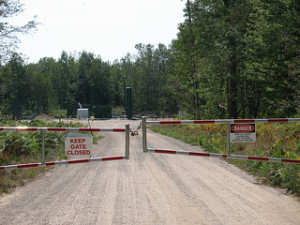 Kalkaska has become the centre of fracking in Michigan with more fracking permits and active applications than any other county in the state. What’s more, not only is Canadian company Encana planning to frack 500 new deep shale wells in the area but they are also breaking records with the amount of water they are using to frack Kalkaska’s wells. According to the National Wildlife Federation’s report Hydraulic Fracturing in the Great Lakes Basin: The State of Play in Michigan in Ohio, most fracked wells in the Utica shale use between 7.5 and 22.7 million litres of water but Encana has reported that it used 45 million litres of groundwater per well to frack the Excelsior 2-25and Garfield 1-25 wells and 80 million litres of groundwater to frack its Excelsior 3-25 well. Recent news reports revealed that Ecana wants to withdraw 15 billion litres of water for the 500 new wells they plan to frack.
Kalkaska has become the centre of fracking in Michigan with more fracking permits and active applications than any other county in the state. What’s more, not only is Canadian company Encana planning to frack 500 new deep shale wells in the area but they are also breaking records with the amount of water they are using to frack Kalkaska’s wells. According to the National Wildlife Federation’s report Hydraulic Fracturing in the Great Lakes Basin: The State of Play in Michigan in Ohio, most fracked wells in the Utica shale use between 7.5 and 22.7 million litres of water but Encana has reported that it used 45 million litres of groundwater per well to frack the Excelsior 2-25and Garfield 1-25 wells and 80 million litres of groundwater to frack its Excelsior 3-25 well. Recent news reports revealed that Ecana wants to withdraw 15 billion litres of water for the 500 new wells they plan to frack.
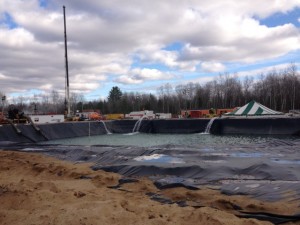 Michigan may soon be the state with the most fracking within the Great Lakes Basin, making Kalkaska County the centre of fracking in the Great Lakes Basin. Ohio and Pennsylvania are Great Lakes states with a significant amount of fracking but most of the fracking within these states occurs outside of the Basin.
Michigan may soon be the state with the most fracking within the Great Lakes Basin, making Kalkaska County the centre of fracking in the Great Lakes Basin. Ohio and Pennsylvania are Great Lakes states with a significant amount of fracking but most of the fracking within these states occurs outside of the Basin.
Next we drove down a dirt road called Sunset Trail and arrived at what Paul calls “Michigan’s first superpad,” known as the Oliver pad. The pad currently has three wells, which were completed in November of 2011 and are now producing wells. There are five more to come, for a total of eight wells. Standing on a small hill just outside the Oliver pad, we saw Encana’s holding tanks of condensate and brine. The site is clean, neat and almost sparse, with no traces of the toxic mixture that Encana used to frack the three wells on site – a very different picture from when the wells were being fracked. But the real threat is what can’t be seen above ground. Encana will draw groundwater in Kalkaska resulting in the loss of approximately 1.1 billion litres from the North Branch of the Manistee River. The North Branch of the Manistee River, a coldwater trout stream, is roughly 1400 feet from where we stood looking at the fracked wells of the Oliver pad.
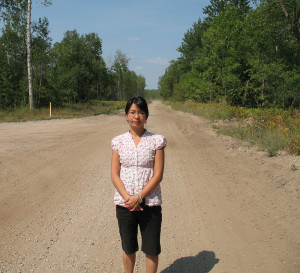 As we walked on Sunset Trail which is in the Pere Marquette State Forest, Paul tells us the story of how back in May 2012, Team Services, a company contracted out by Encana, sprayed over 150,000 litres of fracking flowback on the very road we were walking on.
As we walked on Sunset Trail which is in the Pere Marquette State Forest, Paul tells us the story of how back in May 2012, Team Services, a company contracted out by Encana, sprayed over 150,000 litres of fracking flowback on the very road we were walking on.
We drove down a few roads and arrived at the North Branch of the Manistee River. It looks small and unassuming but is a tributary to the Manistee River, which itself is a winding river of over 300 kilometres that eventually snakes its way to Lake Michigan. As mentioned, Encana’s fracking projects will result in the loss of approximately 1.1 billion litres from the North Branch.
Encana has other well sites in the county including the Garfield well in Garfield Township which used 45 million litres of water in December 2012 as well as the Westerman well site in Rapid River Township where residents have raised concerns about water well failures after fracking began.
Encana’s proposed fracking plans are a threat to the county’s water sources, Lake Michigan and the Great Lakes Basin. The shorelines of Lake Michigan are already under stress, with Lakes Michigan, Ontario and Erie having the highest levels of cumulative stress. Several municipalities in Michigan have already placed a moratorium on fracking.
The Committee to Ban Fracking in Michigan has begun a statewide ballot initiative to “prohibit the new type of horizontal fracking and frack wastes in Michigan.” 258, 088 signatures are required in order for Michigan to hold a referendum on the issue in 2014. Click here to endorse this initiative.
As Maude Barlow points out in her report Our Great Lakes Commons: A People’s Plan to Protect the Great Lakes Forever, while there are many political jurisdictions governing the Great Lakes Basin, it is, in fact, one integrated watershed and needs to be seen and governed as such. We need to work towards banning fracking around the lakes in order to protect the entire Great Lakes Basin.
To read background information about fracking in Michigan, click here.
To view more pictures from this trip, click here.
